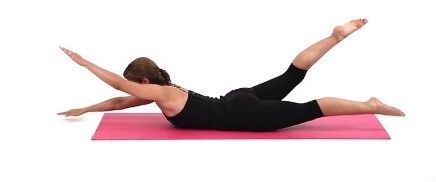SWIMMING MOTION
Correct body alignment is crucial for swimmers as malalignment can cause increased resistance through the water, reducing streamlining and consequently leading you to work harder than necessary. This will lead to earlier fatigue, increase your injury risk and possibly effect your speed and endurance. Specific exercise programs can be helpful to make sure you have the right flexibility, strength and body awareness to be able to maintain alignment over any distance.

FUNCTIONAL ISSUES WHICH CAN AFFECT SWIMMERS AND IMPEDE THEIR PERFORMANCE
- Hip drop during breaststroke due to poor abdominal strength. This will reduce the propulsion phase out of the water and increase the risk of injury to the shoulders, neck and back.
- Lack of upper back extension and rotation can also reduce the propulsion phase in all strokes, as well as reducing arm reach and overloading the shoulder joints.
- Reduced scapula (shoulder blade) stability leads to poor positioning of the shoulder joint, putting strain on the rotator cuff and increasing risk of tears or bursitis.
We have a good article in our blog on ‘Swimmer’s Shoulder’- it has some more details around this so please have a read if this sounds like you!
HOW CAN PILATES HELP SWIMMERS?
Pilates-based exercises are a good choice for strengthening as a swimmer because they can target stability, balance, core control and improve overall body alignment, often in a few simple exercises!
IMPROVED CORE STRENGTH
Although swimmers will work a lot on global muscles it is also important to have a strong internal stability system. When we improve our ‘core’ strength, the larger global muscles do not have to work harder than necessary. Having strength in our deeper stabilising muscles will help improve efficiency in the water and lower the risk of injury. There are many mat-based exercises to increase core strength, however, we often prescribe balancing exercises or exercises on the Pilates Reformer as these can help challenge your core even further!
IMPROVED SCAPULA (SHOULDER BLADE) STABILITY
Most of our dynamic shoulder control comes from the muscles around our scapula. It is important for swimmers to have good strength and control of their scapula as it will not only help reduce strain on the shoulder, but on the rest of the body. Improving the strength around the scapula will allow you to have more strength and power during the ‘pull’ phase through the water.
IMPROVED RANGE OF MOTION AND FLEXIBILITY
Plenty of mobility is needed in the shoulders and upper back to be a good, efficient swimmer. Swimmers’ need a good reach through the arms to pull and propel themselves forwards through the water. They also need upper back extension to lift out of the water at times and rotation to perform their stroke correctly and reduce the load on the shoulder joints. There are many Pilates exercises that increase swimming-specific flexibility.
IMPROVED BODY AND MOVEMENT AWARENESS
Pilates exercises involve focused purposeful body orientation, balance and a deliberate pace. Taking part in Pilates exercises will improve your postural/body awareness which can carry-over well into the water. You will learn to feel when you are deviating from an ideal position and how to activate the correct muscles.
All of the above should together lead to GREATER ENDURANCE AND FASTER TIMES!
The compound nature of many Pilates exercises means that the trunk, shoulder girdle, pelvis and hips can be activated/coordinated together to work as a team rather than being isolated separately. This will increase efficiency of muscle recruitment, increase overall strength of the stroke and lead to a more fluid, aligned and controlled motion.
Exercise examples
- MAT: Prone swimmer
Involves core activation, scapula stability, gluteal & back muscle activation and spinal extension

- REFORMER: Plough
Focuses on strength and control of shoulders, mid back, abdominals, gluteals and hamstrings in a position which is functional for swimming

- WUNDA CHAIR: Cobra
Focuses on scapula control and stability, thoracic spine extension, activation of deep abdominals, gluteals and hamstrings

